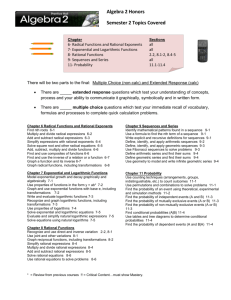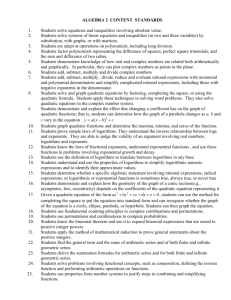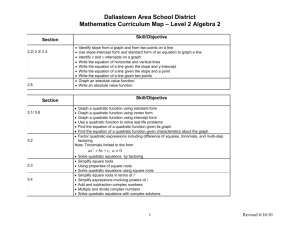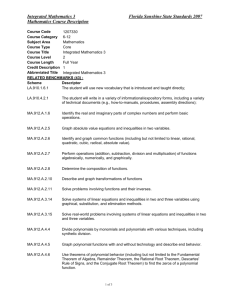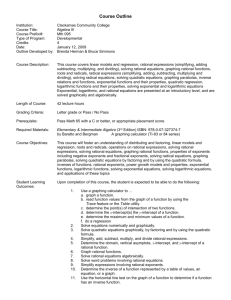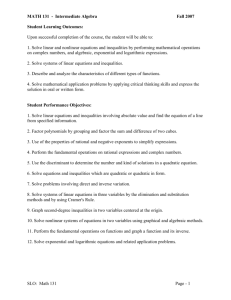HIBBING COMMUNITY COLLEGE
advertisement
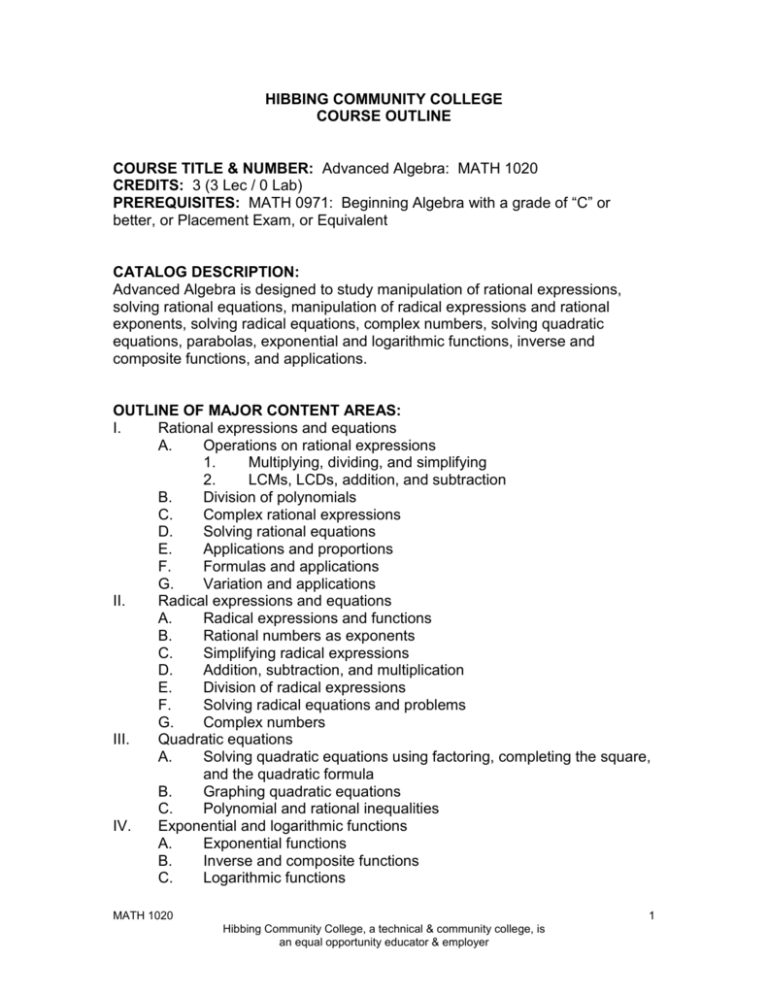
HIBBING COMMUNITY COLLEGE COURSE OUTLINE COURSE TITLE & NUMBER: Advanced Algebra: MATH 1020 CREDITS: 3 (3 Lec / 0 Lab) PREREQUISITES: MATH 0971: Beginning Algebra with a grade of “C” or better, or Placement Exam, or Equivalent CATALOG DESCRIPTION: Advanced Algebra is designed to study manipulation of rational expressions, solving rational equations, manipulation of radical expressions and rational exponents, solving radical equations, complex numbers, solving quadratic equations, parabolas, exponential and logarithmic functions, inverse and composite functions, and applications. OUTLINE OF MAJOR CONTENT AREAS: I. Rational expressions and equations A. Operations on rational expressions 1. Multiplying, dividing, and simplifying 2. LCMs, LCDs, addition, and subtraction B. Division of polynomials C. Complex rational expressions D. Solving rational equations E. Applications and proportions F. Formulas and applications G. Variation and applications II. Radical expressions and equations A. Radical expressions and functions B. Rational numbers as exponents C. Simplifying radical expressions D. Addition, subtraction, and multiplication E. Division of radical expressions F. Solving radical equations and problems G. Complex numbers III. Quadratic equations A. Solving quadratic equations using factoring, completing the square, and the quadratic formula B. Graphing quadratic equations C. Polynomial and rational inequalities IV. Exponential and logarithmic functions A. Exponential functions B. Inverse and composite functions C. Logarithmic functions MATH 1020 1 Hibbing Community College, a technical & community college, is an equal opportunity educator & employer D. E. F. G. Properties of logarithmic functions Natural logarithmic functions Solving exponential and logarithmic equations Modeling with exponential and logarithmic functions COURSE GOALS/OBJECTIVES/OUTCOMES: Students will: 1. find all numbers for which a rational expression is not defined or that are not in the domain of a rational function. 2. rewrite a rational expression by multiplying by a form of 1. 3. simplify rational expressions. 4. multiply rational expressions and simplify. 5. divide rational expressions and simplify. 6. find the LCM of several algebraic expressions by factoring. 7. add and subtract rational expressions. 8. simplify combined additions and subtractions of rational expressions. 9. divide a polynomial by a monomial. 10. divide a polynomial by a divisor that is not a monomial, and if there is a remainder, express the result in two ways. 11. use synthetic division to divide a polynomial by a binomial of the type x-a. 12. simplify complex rational expressions. 13. solve rational equations. 14. solve work problems and certain basic problems using rational equations. 15. solve applied problems involving proportions. 16. solve motion problems using rational equations. 17. solve a formula for a variable. 18. find an equation of direct variation given a pair of values of the variables. 19. solve applied problems involving direct variation. 20. find an equation of inverse variation given a pair of values of the variables. 21. solve applied problems involving inverse variation. 22. find equations of other kinds of variation given values of the variables. 23. solve applied problems involving other kinds of variation. 24. find principal square roots and their opposites, approximate square roots, find outputs of square-root functions, graph square-root functions, and find the domains of square-root functions. 25. simplify radical expressions with perfect-square radicands. 26. find cube roots, simplifying certain expressions, and find outputs of cuberoot functions. 27. simplify expressions involving odd and even roots. 28. write expressions with or without rational exponents, and simplify, if possible. 29. write expressions without negative exponents, and simplify, if possible. 30. use the laws of exponents with rational exponents. 31. use rational exponents to simplify radical expressions. 32. multiply and simplify radical expressions. MATH 1020 2 Hibbing Community College, a technical & community college, is an equal opportunity educator & employer 33. 34. 35. 36. 37. 38. 39. 40. 41. 42. 43. 44. 45. 46. 47. 48. 49. 50. 51. 52. 53. 54. 55. 56. 57. 58. 59. 60. 61. 62. 63. 64. 65. 66. divide and simplify radical expressions. add or subtract with radical notation and simplify. multiply expressions involving radicals in which some factors contain more than one term. rationalize the denominator of a radical expression having one term in the denominator. rationalize the denominator of a radical expression having two terms in the denominator. solve radical equations with one radical term. solve radical equations with two radical terms. solve applied problems involving radical equations. solve applied problems involving the Pythagorean theorem and powers and roots. express imaginary numbers as bi, where b is a nonzero real number, and complex numbers as a+bi, where a and b are real numbers. add and subtract complex numbers. multiply complex numbers. write expressions involving powers of i in the form a+bi. find conjugates of complex numbers and divide complex numbers. determine whether a given complex number is a solution of an equation. solve quadratic equations using the principle of square roots and find the x-intercepts of the graph of a related function. solve quadratic equations by completing the square. solve applied problems using quadratic equations. solve quadratic equations using the quadratic formula. solve applied problems involving quadratic equations. solve a quadratic equation for a specified variable. determine the nature of the solutions of a quadratic equation without solving. write a quadratic equation having two numbers specified as solutions. solve equations that are quadratic in form. graph quadratic functions of the type f(x)=ax2 and then label the vertex and the line of symmetry. graph quadratic functions of the type f(x)= a(x-h)2 and then label the vertex and the line of symmetry. graph quadratic functions of the type f(x) = a(x-h)2 +k, finding the vertex, the line of symmetry, and the maximum or minimum y-value. for a quadratic function, find the vertex, the line of symmetry, and the maximum or minimum value, and graph the function. find the intercepts of a quadratic function. solve maximum-minimum problems involving quadratic functions. fit a quadratic function to a set of data to form a mathematical model, and solve related applied problems. solve quadratic and other polynomial inequalities. solve rational inequalities. graph exponential equations and functions. MATH 1020 3 Hibbing Community College, a technical & community college, is an equal opportunity educator & employer 67. 68. 69. 70. 71. 72. 73. 74. 75. 76. 77. 78. 79. 80. in 81. 82. 83. 84. 85. 86. 87. graph exponential equations in which x and y have been interchanged. solve applied problems involving applications of exponential functions and their graphs. find the inverse of a relation if it is described as a set of ordered pairs or as an equation. given a function, determine whether it is one-to-one and has an inverse that is a function. find a formula for the inverse of a function, if it exists, and graph inverse relations and functions. find the composition of functions and express certain functions as a composition of functions. determine whether a function is an inverse by checking its composition with the original function. graph logarithmic functions. convert from exponential equations to logarithmic equations and vice versa. solve logarithmic equations. express the logarithm of a product as a sum of logarithms and vice versa. express the logarithm of a power as a product. express the logarithm of a quotient as a difference of logarithms and vice versa. convert from logarithms of products, quotients, and powers to expressions terms of individual logarithms and vice versa. simplify expressions of the type logaak. use the change-of-base formula to find logarithms with bases other than e or 10. graph exponential and logarithmic functions, base e. solve exponential equations. solve logarithmic equations. solve applied problems involving logarithmic functions. solve applied problems involving exponential functions. MNTC GOALS AND COMPETENCIES MET: N/A HCC COMPETENCIES MET: Communicating Clearly & Effectively Thinking Creatively & Critically STUDENT CONTRIBUTIONS: The student will attend class regularly, participate in class discussion, complete daily assignments, in class exercises, exams, and a comprehensive final examination. The student will spend a minimum of two hours completing MATH 1020 4 Hibbing Community College, a technical & community college, is an equal opportunity educator & employer assignments for every hour in class. These must be accomplished in such a way that they meet minimum standards set by the instructor. STUDENT ASSESSMENT SHALL TAKE PLACE USING INSTRUMENTS SELECTED/DEVELOPED BY THE COURSE INSTRUCTOR. SPECIAL INFORMATION: (SPECIAL FEES, DIRECTIVES ON HAZARDOUS MATERIALS, ETC.): The student may be required to provide a calculator for this course. If a specific calculator model is required, this model will be specified by the instructor on the course syllabus. Examples of calculators which may be required include but are not limited to the following: the TI89 and the TI Voyage 200. AASC APPROVAL DATE: October 20, 2010 REVIEW DATE: October 2015 MATH1020:so 102010 MATH 1020 5 Hibbing Community College, a technical & community college, is an equal opportunity educator & employer

